But First...Spring!
We've been getting the typical March warm-up: Days in the sixties, then a string of days where it stays in the forties (that's degrees Fahrenheit). We've had blizzards in April, so the only sure way to avoid the cold is to not put out any frost-sensitive plants until after Memorial Day weekend. That means my indoor plants are going to stay that way until late May.
Native perennials, on the other hand, follow their own schedule. I already have some things popping up:
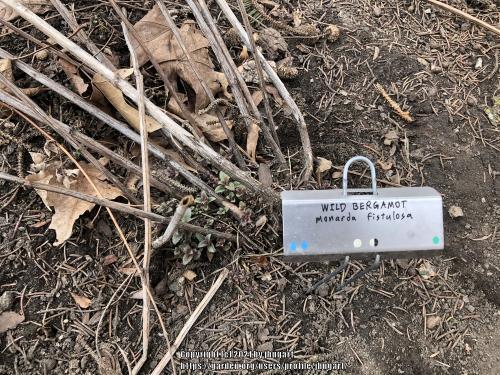
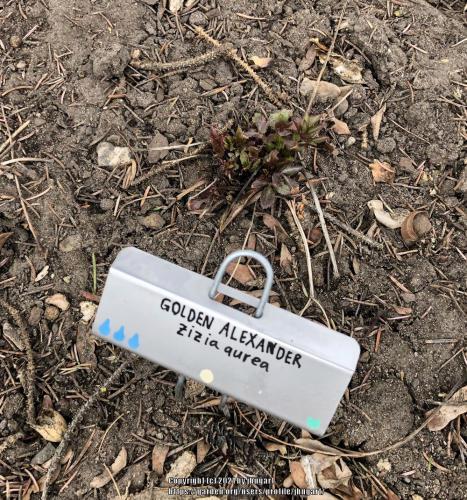
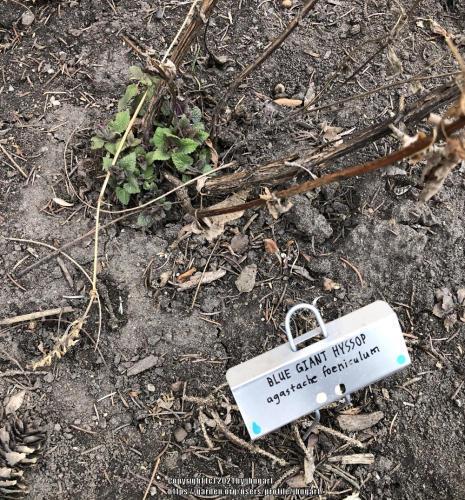
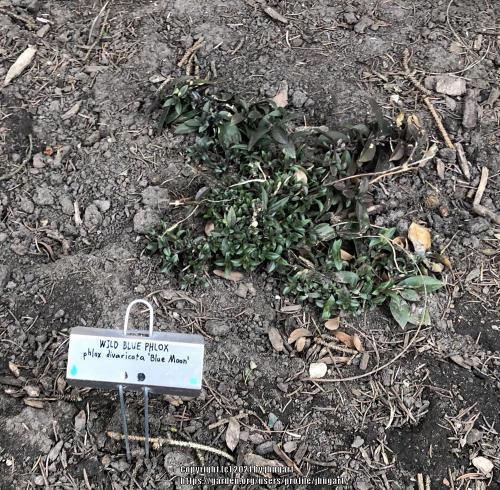
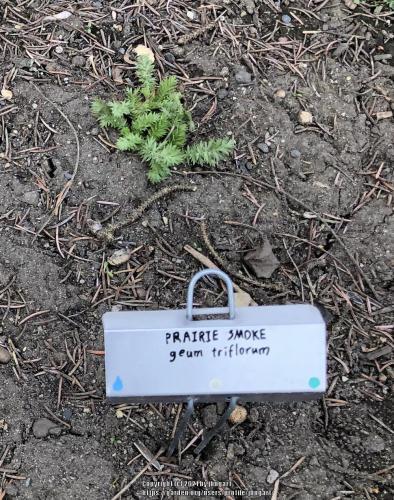
And the wildlife is notable. We had a male House Sparrow building a nest in a box we have (he has not returned for some time, though):
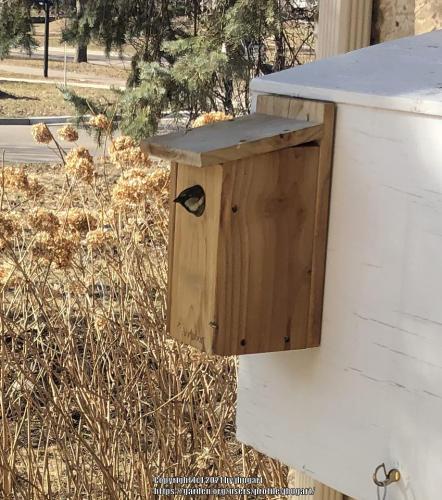
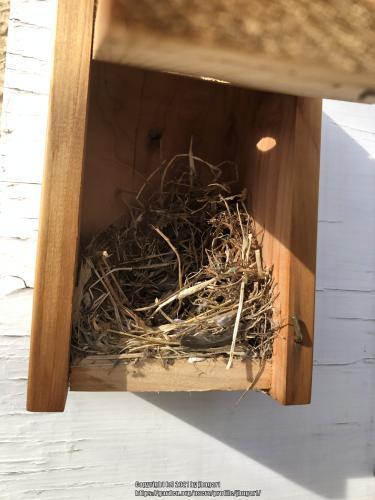
And the Mallard ducks have shown up again, though we've had some earlier this year:

The snow in the yard and driveway and such is all gone. It could come back anytime, though. This is what things looked like in February:
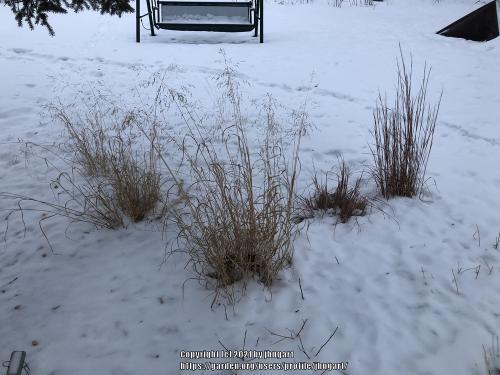
And this is a more recent image (grasses are on the left):
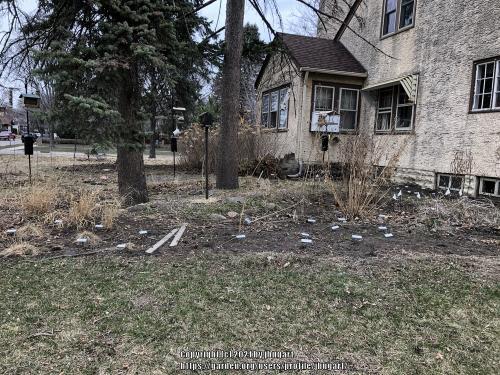
Back to the Book
But I wanted to convey noteworthy things from Month-by-Month Gardening in Minnesota, by Melinda Myers, for the month of March. There's a lot more detail in the book, but I wanted you to see the kinds of things she advises. I think this is a good book any Minnesota gardener should have.
Chapter One: Annuals
With snow-free days, measure you beds so you can calculate how many plants you need to get. You can also plan where new beds should go, and do soil preparation if the soil can be worked.
You can continue to seed annuals indoors, but don't do it outside yet. Pansies started indoors can go into a cold frame this month, but you'll need to vent them on warm days.
Chapter Two: Bulbs, Corms, Rhizomes, and Tubers
Start recording bloom times using a journal, or a camera, or both.
You can start planting bulbs indoors starting in late March. There are tips on growing your own Easter lilies!
Frost-heaving in your yard can change the depth of bulbs and such. Check for this.
Chapter Three: Herbs & Vegetables
Finish your garden plan. Decide on how much soil amendment you will need.
You can plant some indoor seeds in March, to be moved to your outdoor garden later.
Remove debris from your garden and do a general clean-up. Take soil tests. Be careful working the soil when it is too wet, the clods will stay all year. If you squeeze some in your hand, it should break apart if it is the right moisture content.
For a vegetable garden, you can cover with plastic to help warm the soil and cause weeds to sprout. Cultivate the weeds into the soil (don't do this by deep hoeing), and you have prepared for planting.
Chapter Four: Lawns
This is a good month to get your lawn mower ready for summer. It is still too early to plant grass seed.
You can use a leaf rake to fluff the grass to avoid snow mold. Don't rake frozen or wet grass, though.
Chapter Five: Perennials & Ornamental Grasses
Finish your plans and plant list. Beginners will benefit from fewer species, but more of each species.
Soil tests are the thing to do this time of year. New areas should definitely be tested; established areas should be retested every three to five years.
Chapter Six: Roses
Place your rose order. Keep winter shelters in place in outside roses. The cones and such can be removed after a week of above-freezing temperatures, but keep them handy in case of a drop in temperatures (she says in many of these sections that northern Minnesota may still be blanketed by snow, while the southern half can alternate between warm sun and blizzards).
Don't prune outdoor roses until the weather warms up.
Chapter Seven: Shrubs
Check with nurseries that carry unusual plants that interest you. Complete your landscape plan.
This is a great time to transplant shrubs. It may be easier to replace overgrown shrubs, rather than move them.
You can start the repair work for salt-laden soils.
Remove and destroy Eastern Tent Caterpillar eggs on flowering plums and cherries. Prune out gold-colored branches on dogwood.
Chapter Eight: Trees
This is a good time to transplant trees.
Prune or remove damaged branches. Complete pruning before trees leaf out. This is the last time to prune oaks.
Check the soil moisture before watering. If it has been a dry time, or not much snow, you may need to add some.
Chapter Nine: Vines & Groundcovers
Remove winter-damaged leaves and stems. Complete your planning and figure out how many plants you need to order for new plantings. Edge your planting beds with a sharp spade. Start pruning vines and groundcovers.
Time for February
I wanted to share what's relevant for February (I wasn't able to get this published last month!) in Melinda Myers' Month-by-Month Gardening in Minnesota. Again, February in Minnesota is generally when we get our coldest weather; for instance, our high today was in single digits Fahrenheit, and the wind chill has been twenty (or so) degrees below zero...and our air-temperature high tomorrow will be negative!
Plus, we had more snow in the past week, so there's nothing being done to the ground right now. My main task is keeping the bird feeders going. So most of what will happen for the garden is planning.
Chapter One: Annuals
As I noted before, I don't put annuals out, except for herbs. Most of this chapter's advice for this month is about ordering seeds and getting your seed-growing indoor set-up all ready.
Chapter Two: Bulbs, Corms, Rhizomes, and Tubers
Again, I don't plant any seasonal bulbs, yet.
Chapter Three: Herbs & Vegetables
Now we're into something of interest in my yard!
Planning
Myers notes that you should finalize your vegetable garden and herb garden plan. Think about what your family will eat, what is used in your favorite recipes, and consider what's the best value. Some vegetables, for instance, taste better when you grow them yourself; others, though, may take a lot of effort, and it would be better to buy it at the local farmer's market.
You also need to think about space needs. A tomato plant produces several tomatoes; a corn plant produces one or two ears. So you may need more space if you want to eat fresh corn all the growing season.
Also think about how much you want to grow for eating fresh, and how much you will preserve, through canning or drying.
Planting
Start onions from seeds indoors.
Care
Harvest any indoor herbs you have, freeze excess in ice cubes. If you have things like carrots stored in the garden itself, wait for a thaw day to dig them out.
Inventory your tools. Do any cleaning necessary, and sharpen the edges of shovels and other such tools.
Watering
This covers specifics of indoor herb gardens and seed flats.
Fertilizing
Make sure any indoor plants aren't having light problems or nutrient problems. Don't use fertilizer on onion seedlings, though.
Problems
There's advice to check for insect and fungus problems.
Grooming
Prune leggy herbs.
Chapter Four: Lawns
This is great time to take your lawn-mower for a tune-up and blade sharpening at the hardware store or garden center.
Chapter Five: Perennials & Ornamental Grasses
Review photos of your garden, and sketch ideas for new plantings. You can grow seedlings at home right now.
Be sure to add winter mulch if needed. You want to be careful about perennials taking a thaw as Spring, and sprouting too early. Extra mulch can help.
Wait for the worst of winter to pass before cleaning the garden. Some plants benefit from the stems standing for a while. (Some beneficial insects hibernate in stems, too!)
Chapter Six: Roses
Finalize your plans for roses in your garden. Attend any local rose society: they often have lots of information on how to grow roses in your area.
Check your garden's roses to make sure all winter protection is still in place.
Chapter Seven: Shrubs
Update your landscape plan for shrubs, and visit any early garden shows. Experts there can give you lots of advice.
Too early to plant, but look for shrubs that might need to be transplanted to somewhere else in your garden. When the soil thaws, they can be moved.
Look for animal damage, and add additional protection as needed.
Prune damaged or hazardous branches as found. You can continue to prune summer- and fall-blooming plants until growth begins in spring.
Chapter Eight: Trees
Research and plan trees for your garden. Winter hikes through botanical gardens can be fun. Consider getting smaller trees; while you have to wait for them to grow to match a tree you buy in a larger size, those larger trees may take a few years to adjust. A tree you start smaller may grow bigger!
Now is a good time to contact nurseries about what stock they have for trees, but planting is still at least a month away.
Shovel snow before using de-icing salts. Consider using plant-friendly options like sand, instead.
Still a good time for pruning trees, though maples may have running sap that makes it a messy job in late winter.
Chapter Nine: Vines & Groundcovers
Buy or build support structures for new plantings. Install them before you dig in new plantings, so that root structures aren't damaged.
Wait until March or April to do routine pruning.
It Pays to Talk With Friends
I got a comment on my Spring Ephemeral post about willows. This is from a friend with whom I've been exchanging Tree-Mail, but it points out the value of paying attention to other people. I hadn't been thinking of putting willows in my yard, but she noted that can be an early pollen source.
So let's take a look at some options!
Willow Research
I started with the Minnesota Wildflowers web site, and looked for all the Salix species, and eliminated any that weren't normally growing in Ramsey county, where I live. They are all perennials.
Salix amygdaloides
The Peach-leaved Willow grows from 13 to 65 feet, and normally occurs in wetlands. It blossoms from May to June. According to garden.org, it attracts birds and bees, the former like the fruit, the latter are pollinators. It likes full sun and tolerates poor soil, and will handle a slightly acidic or neutral soil pH.
Salix bebbiana
The Bebb's Willow grows from 4 to 25 feet, and normally occurs in wetlands. It blossoms from May to June. Garden.org lists is as the Beaked Willow, and it also attracts birds and bees. It likes full sun and tolerates poor soil, and will handle a slightly acidic or neutral soil pH.
Salix candida
The Sage-leaved Willow grows from 12 to 40 inches (under 4 feet!), and is an obligate wetland plant (this likely makes this not a good choice for me). It blooms from April to June, so earlier than the first two. Garden.org lists it at the Hoary Willow, but doesn't give much information. It seems to prefer full sun.
Salix discolor
This is the Pussy Willow, and is a plant I had considered. It grows from 6 to 30 feet high, which I didn't realize, blooms from April to May, and prefers wetlands. Garden.org lists it as liking full or partial sun, that it prefers neutral-pH soil, and attracts birds, bees, butterflies, and other beneficial insects. It tolerates poor soil, and is both drought- and flood-resistant.
Salix eriocephala
This is the Missouri River Willow, which grows 6 to 22 feet tall, blooms from April to May, and prefers wetlands. Garden.org doesn't have much, but suggests that it tolerates poor soil and is pollinated by bees. It seems to prefer full sun.
Salix humilis
Known as the Prairie Willow, this grows 1 to 10 feet tall, blooms from April to May, and is usually not found in wetlands, which is noteworthy. Garden.org indicates that it can handle partial as well as full sun, that it likely gets to 4 feet high, that it attracts birds and bees, and tolerates poor soil. This one stands out to me so far, because of the manageable height and that it doesn't require wet conditions all the time.
Salix interior
Called the Sandbar Willow, this grows 6 to 22 feet tall, blooms from May to July, and is usually found in wetlands. Garden.org notes that it tolerates full or partial sun, likes slightly acidic or neutral-pH soil, normally grows 6 to 8 feet, tolerates poor soil, is flood resistant, and birds will eat the fruit.
Salix lucida
This is the Shining Willow, which grows 3 to 20 feet tall, blooms from May to June, and is usually found in wetlands. Garden.org calls it the Greenleaf Willow, says it requires full sun, handles acidic or neutral-pH soil, attracts birds and bess, is flood tolerant, and tolerates poor soil.
Salix nigra
Called the Black Willow, grows 15 to 80 feet tall, blooms from May to June, and is almost always in wetlands, or may even require such a planting. Garden.org says it can handle everything from full sun to full shade, has fragrant flowers, the fruit is edible to birds, and attracts birds, bees, and butterflies. But it also notes it is suitable for bog gardening.
Salix pedicellaris
Known as the Bog Willow, it grows no more than five feet high, blooms from April to June, and requires wetlands to grow. Garden.org has next to nothing about this plant.
Salix petiolaris
Called the Meadow Willow, this grows 3 to 20 feet, blooms from April to May, and pretty much requires a wetland to grow. Garden.org doesn't add much except that it is pollinated by bees. It seems to prefer sun.
Salix pyrifolia
Called the Balsam Willow, this grows 1 to 13 feet, blooms from May to June, and is usually found in wetlands. Garden.org doesn't add much. It wants full sun.
Salix serissima
Known as the Autumn Willow, it grows 3 to 10 feet, blooms from May to June, and is obligated to be in wetlands. Garden.org doesn't add much. It wants sun.
Evaluation of the Willows
As I said earlier, these are all Minnesota native plants, all woody perennials. From what I've read on-line, you can prune willow like you would any other tree or bush, including cutting back taller stems and shortening branches. This suggests that I could train any willow to whatever height I want, except that I'm increasing my effort, and I try to take an easier path when I can!
If I had to pick only one, it would probably be Salix humilis, the Prairie Willow. It doesn't grow more than ten feet tall, is usually not found in wetlands, and handles partial sun and poor soil.
I have to also give a nod to Salix discolor, the Pussy Willow. I've always liked the look of the wands one sees in flower arrangements. It can grow tall, though the Garden.org entry says it is 15 to 20 feet, which isn't bad at all. And it draws a number of creatures, will tolerate drought as well as flood, tolerates salt, and tolerates partial shade as well as full sun.
What Next?
We're having bitterly cold temperatures this weekend, so going outside is being kept to a minimum. I'm going to post the February information from the month-by-month gardening book soon.
What are Spring Ephemerals?
As I noted earlier, winter is a good time for planning. We have a snowstorm approaching, so sitting inside to investigate plants I could add to my garden is a good use of my time.
This time, I'm looking at spring ephemerals. These are forbs -- non-grass, herbaceous flowering plants -- that pop-up before trees and shrubs leaf out in the early spring, such as April and May; some in Minnesota might even start blooming in late March. My goal in selecting these plants is to provide something for pollinators that are active in the early spring.
Researching
There are different resources for hunting up information on plants that bloom in the spring.
Garden.org has a plant characteristic search that lets you pick attributes like "Spring ephemeral" or "Hardiness Zone" and get a list of results. However, it doesn't let you select for plants native from a given state, and I want to pick Minnesota natives.
Minnesotawildflowers.info is good for Minnesota-native wildflowers, and has its own advanced search. There you can search for plants found in a given county, or blooming in a given month, and there's an option to select native plants.
There is a paid site, Gardenia.net, which can be very specific about soil types, soil pH, and so on. In some ways, it appears more thorough than garden.org, but I think it doesn't have as many entries. While you can do some things for free, you have to pay if you want to create multiple lists.
By using all these resources, not to mention Google searches and books I have, I could build up a list of possible plants. But I needed to filter the options. For instance, I could eliminate plants that aren't native in my state or county, and I wanted perennials, not annuals. I've also checked with a friend to see what he's suggested.
The Short List
I've used garden.org's list feature to make a list of spring ephemeral plants that interested me. I added some categories and notes. Here's the plants that are included:
What's All This, Then?
January is a slow month for gardening, and I had an idea to talk about the beneficial things I've found where I am. Maybe there are similar things where you are.
I Live in Minnesota
I was neither born nor raised here, but I have lived here over 25 years. I like it, it's a neat place. For gardening, it has some nice assets; I'll describe them so you will know what I'm talking about. I suggest that you check where you live, and see if there are similar things that you can find, to help you with your gardening efforts.
The Minnesota State Horticultural Society (MSHS)
This is an organization dedicated to "growing cold-climate gardeners," according to their mission statement. They have a magazine with good articles and lists of events that is bimonthly, you get discounts on classes and purchases at select gardening centers, and two free tickets to the Minneapolis Home & Garden show.
You do not get a discount to visiting the University of Minnesota Landscape Arboretum, but you do get a discount on buying a membership there.
It is nice to have access to resources geared for the state in which I live. I have on-line access to the archives of Northern Gardener, their magazine. The membership card is now digital, so it shows in my iPhone Wallet app, making it convenient to use, and it doesn't wear out from handling! I've gotten a lot of value from the garden center discount, and found out about such businesses that I didn't know about; they also have a better selection of the plants which interest me than the more mainstream places.
I've noticed, when helping others, that while a state may have a horticultural society, it may be an industry organization, not something geared for the home gardener. Check around and see what you can find, because there is probably some sort of organization in your area: if not for your state, maybe for your county, or region.
University of Minnesota Landscape Arboretum
This is over 1,200 acres of wild and cultivated land, with a driving route and multiple trails. What's nice about it is that if you want, say, a hedge in your yard, you can go here and visit the hedge section, and see what the various species look like in use. They have a big library, a nice cafeteria, a good store, and often have a Master Gardener on hand to answer questions. It is a beautiful place, and every gardener can find something of interest; for instance, there is a Hosta Glade, showcasing different varieties, and a Wildflower Garden, where you can see what the native wildflowers look like.
There is a lot the arboretum offers, and if your state has something similar, you should look into it. More likely than not, a local university (often a state school) will have something like this.
University of Minnesota Extension
We have a very useful extension service at the University of Minnesota. Extension services in the USA are a cooperative effort between the US Department of Agriculture (USDA) and land-grant universities. They offer information and services like testing to residents in order to advance and benefit the community.
Our service has information on native plants, and also does soil testing. They also cover things like home finances, or commercial food production. For instance, the home page of the Yard & Garden section provides links for weed identification or "What's wrong with my plant?"
Chances are, if you live in the USA, there is a university offering an extension service in your state. Finding out what they offer and what information they provide will likely be of benefit to you.
Minnesota Wildflowers
This web site provides a listing of varies Minnesota wildflowers, as well as some bushes and trees. What's nice is that it tells you if something is native, or invasive, as well as what kind of growing conditions it requires, where in the state it has been found, how big it gets, and so on. I've found it helpful for understanding when the plants flower, and for hunting for plants for specific characteristics, like when plants flower or what color the flowers are.
It is free, but there is a suggested donation, which I heartily recommend. I find this to be a nice, state-focused resource that complements garden.org's extensive plant database.
While you may not find a state-specific site for your state, you may find some other sites if you start hunting for "(your state name) wildflowers" or "(your state name) native plants" on the Internet. Remember, though, that anyone can post something on the Internet, so check the quality of a site before you start relying on it.
Wild Bird Store
This is a local chain of stores that specializes in providing feeders, houses, and food for the wild birds which frequent our area. This chain in particular offers on-line resources, that you can also get on paper in-person, that tell you what sorts of plants are good to plant, how to set up a yard for feeders, and so on.
Chances are, there is something similar in your area. I didn't find out about this store until I was with my daughter, driving to a sandwich shop in a strip mall after she'd been to a rock-climbing gym, and noticed the store in that mall. If I were to move to another state, I know I'd be looking for something similar to this.
The Public Library
This is a useful way to review different books before you buy them. Of course, the public library may not have every book you want, and some books you find may be less than satisfactory. But as a free resource, it is extremely useful.
The Lawns-to-Legumes Program
This is something that probably isn't in your state yet, for Minnesota's program is only a pilot. In order to combat habitat loss for native pollinators, Minnesota started their lawns-to-legumes program to encourage people to replace lawns with Minnesota-native plants that would attract native insect species. The program provides a grant to help cover the cost of such conversion, and there's a lottery for winning the grants. However, they do provide resources on the kinds of plants to consider, and how to go about preparing to change over to a pollinator-friendly planting.
If your state doesn't have such a program, there may be a local group that is advocating for such a program, so hunting for this sort of thing, like "how do I replace my lawn with wildflowers", will probably help.
Beware Over-Indulgence!
I'm sure most people have found that for some things, like news of current events, you hit a saturation point where you just have to break-off in order to preserve your sanity (or avoid a headache). You can get the same overload with all the information on yards and gardening. There will always be conflict between different groups or books that tell you how or what to do.
What I recommend is that you figure out your own priorities. What matters most to you? What is your focus?
In my case, my focus is on attracting wild birds to the yard, and that means making plants which birds will use (as food or shelter), and doing things to attract more insects. I then found resources in support of that focus, from reputable organizations, and was able to work out what I wanted to do.
If your focus is a vegetable garden, or a rose garden, then concentrate on that. There is so much information out there that you will be quickly overwhelmed if you try to learn it all, or expand outside of your focus. It is OK to do things in small steps, working on small areas. Even planting something in a pot is a good start.